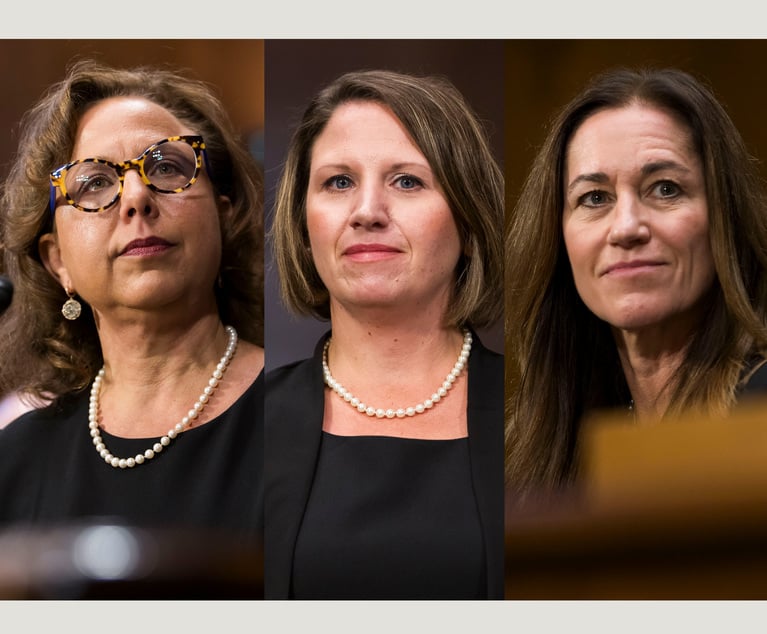Mitigation of Environmental Risks Caused by Extreme Weather
According to the Pennsylvania Emergency Management Agency, flooding is the most frequent and damaging natural disaster impacting the commonwealth. Many of Pennsylvania's communities are located adjacent to waterbodies.
June 13, 2019 at 12:09 PM
8 minute read
 Jillian C. Kirn, Greenberg Traurig
Jillian C. Kirn, Greenberg Traurig
Imagine that you are environmental, health and safety (EHS) counsel or general counsel for a company dealing with a natural disaster. The company's facilities are only partially functional, employees have lost their homes, and business unit functionality has been severely disrupted. You find yourself managing the myriad demands of the federal, state and local environmental agencies, the company's employees and the public. Amidst all this, the media reports that a criminal investigation is forthcoming due to the company's alleged failure to adequately prepare for the event. What could you have done to better prepare for disaster?
This is not just a hypothetical. Each year, businesses in every sector are impacted by any number of floods, tornadoes, forest fires, hurricanes, earthquakes and other geologic phenomena—frequently resulting in significant civil and criminal litigation. According to the Pennsylvania Emergency Management Agency, flooding is the most frequent and damaging natural disaster impacting the commonwealth. Many of Pennsylvania's communities are located adjacent to waterbodies. This vulnerable placement is due, in part, to the commonwealth's historic reliance on waterways for commerce and as an energy source for industry. Many low-lying areas were also developed prior to the identification of floodplains. As a result, business and industry, private property, and infrastructure such as public utilities, bridges and railways are all at risk of sustaining flood-related damage and loss.
The Atlantic hurricane season officially started on June 1 and runs until Nov. 30, making now an opportune time to consider strategies to address environmental liability exposure caused by natural disasters and extreme weather events. It is a perfect time to consider your company's or clients' emergency preparedness strategies, on-site and off-site environmental risks, and pollution insurance coverage.
Aren't Natural Disasters Rare?
Being affected by a natural disaster is not as improbable as you might think, especially for companies with facilities in multiple geographic locations. Continuing with the hurricane example, terms like “100-year floodplain” or “500-year storm” are often used when quantifying flood risks, but are frequently misinterpreted as events that only happen once every 100 or 500 years. The actual definitions of these phrases, based on statistics developed through the Federal Emergency Management Agency's (FEMA) National Flood Insurance Program, might surprise you. Setting aside concerns about the accuracy of the historical data on which the statistics rely, FEMA defines the “100-year floodplain” as an area of land that has a 1% chance of being inundated by flood waters from a bayou, stream or creek in any given year. Similarly, a “100-year storm” is a rainfall event that has the same 1% chance of occurring. Statistically, there is a 26% chance that a “100-year rainfall” will occur during any given 30-year period. Practically, properties face a relatively high (roughly 1-in-4) chance of experiencing a flood at some point during a standard mortgage term.
It is important to note that “100-year rainfall” varies depending on location. According to the National Oceanic and Atmospheric Administration's National Weather Service, the 100-year storm level in Center City Philadelphia is approximately 7.74 inches in 24 hours. A “500-year storm” and “500-year floodplain” are calculated similarly; within any 30-year period, there is a 6% chance that the same Philadelphia location will be flooded by roughly 10.3 inches of rain in 24 hours.
As the climate crisis continues, extreme weather events and flooding seem to occur even more frequently than the statistics might suggest. According to The Weather Channel, the United States has experienced over 30 “500-year” rain events since 2010, and experienced the following 1,000-year rainfall events last summer, alone:
- September 2018, Hurricane Florence
- September 2018, Chesapeake flooding before Florence
- August 2018, Madison, Wisconsin area flooding
- August 2018, Colorado flooding
- June 2018, Northern Wisconsin/Northern Michigan rainfall
- May 2018, catastrophic flooding in Ellicott City, Maryland for the second time in two years
Emergency Preparedness
The National Hurricane Center is often quoted as saying “preparation through education is less costly than learning through tragedy.” Whether in-house or outside counsel, it is always a best practice to identify and mitigate risks. Being thorough and imaginative when considering potential environmental risks may help avoid civil or criminal issues resulting from a natural disaster. In developing an emergency preparedness plan, it is prudent to consider:
- Overall magnitude of potential rain events;
- Impact of rain on specific elevation areas of facility;
- Hazards created;
- Location and loss of primary and backup electrical power;
- Timing of transfer of chemicals; and
- Potential for on-site contaminants becoming off-site contaminants.
Fortunately, there are hazard-assessment tools to help with the identification of risks caused by flooding. One potential option is to conduct a hazard and operability analysis (HAZOP). HAZOPs evaluate what can go wrong; how bad it can get; and how often it may happen. Many facilities already perform HAZOPs, particularly in process areas, but often neglect to conduct a flood-specific HAZOP. Adding a formal risk assessment based on catastrophic flooding and any other likely natural disasters or extreme weather events makes sense.
Last year, the U.S. Chemical Safety Board (the CSB) noted that “… there is a significant lack of guidance in planning for flooding or other severe weather events. Based on other government reports, we know that there is a greater likelihood of more severe weather across the country … it is critical that industry better understand the safety hazards posed by extreme weather events.” In order to heed the CSB's advice and get more planning guidance, it may be advisable to engage an engineer with experience in floodplain analysis to assist with the flood HAZOP development process. That engineer should be able to evaluate technical flood maps, review elevations and consider drainage issues. The HAZOP team should develop an objective approach that can be easily replicated and should include a review of floodplain maps including FEMA's flood insurance study and base flood elevation maps. Once risks are identified, the team should consider prevention and mitigation of those risks including, if necessary, hardening operational units, keeping back-up equipment mobile or locating it in higher elevations within a facility, changing process engineering and shutdown procedures, strengthening tanks, and improving secondary containment.
On-Site Problems Can Become Off-Site Problems
Even with a HAZOP in hand, natural disasters and extreme weather events often cause unanticipated consequences. For instance, wildfires frequently cause releases of chemicals to soil, water and air. Even a residential property might be littered with burned solvent bottles, corroded car batteries and exposed asbestos. A hurricane that causes loss of power, can catalyze explosions of unstable chemicals that result in noncompliant air emissions. Floods that cause waterbodies to overflow can easily turn a carefully siloed Superfund or brownfields site into an extremely messy tangle of liabilities. Of course, delineating every worst-case scenario is impossible (and certainly not happening in a brief article) but in developing emergency preparedness plans, it is worth considering how your environmental risks could affect your neighbors and vice versa.
Preparing Better—Pollution Liability Insurance
In addition to creating and reevaluating emergency preparedness plans, hurricane season is also an ideal time to consider pollution liability insurance. Under both the Federal Comprehensive Environmental Response, Compensation, and Liability Act and Pennsylvania's Hazardous Sites Cleanup Act, without defenses, a current property owner is responsible for the environmental condition of her property regardless of who, or what, caused the contamination. Further, the environmental impacts of a natural disaster on a site may not be immediately obvious but only surface years later when the property owner attempts to sell or lease the property and an environmental site assessment reveals recognized environmental conditions.
Fortuitously, many pollution liability policies do not exclude acts of God. While most properties have flood insurance, it may be worth considering whether the risks at a site, or for a specific company, warrant a more comprehensive pollution liability policy that can cover the fallout of any number of other natural disaster or extreme weather events.
End Goal—Controls for Chaos
A Flood HAZOP and emergency preparedness plan may not prevent unexpected consequences including a potential civil or criminal investigation. However, the completion of a thorough analysis and well-crafted plan may help investigators understand that a company was well prepared. Investigators are not generally looking for perfection (natural disasters are called “acts of God” for a reason) but are looking for evidence that companies identified risks, took meaningful measures to mitigate them, and operated consistent with, or exceeding, industry best practices. There is no one-size-fits-all emergency preparedness strategy, but there is no better time than the present to craft one.
Jillian C. Kirn is an environmental shareholder in the Philadelphia office of Greenberg Traurig. Her practice focuses on complex environmental and energy matters and has included counseling private and government-owned electric power companies during extreme weather events, including Hurricane Maria and Hurricane Florence. Contact her [email protected]
This content has been archived. It is available through our partners, LexisNexis® and Bloomberg Law.
To view this content, please continue to their sites.
Not a Lexis Subscriber?
Subscribe Now
Not a Bloomberg Law Subscriber?
Subscribe Now
NOT FOR REPRINT
© 2025 ALM Global, LLC, All Rights Reserved. Request academic re-use from www.copyright.com. All other uses, submit a request to [email protected]. For more information visit Asset & Logo Licensing.
You Might Like
View All
Pa. Federal District Courts Reach Full Complement Following Latest Confirmation

The Defense Bar Is Feeling the Strain: Busy Med Mal Trial Schedules Might Be Phila.'s 'New Normal'
7 minute read
Federal Judge Allows Elderly Woman's Consumer Protection Suit to Proceed Against Citizens Bank
5 minute read
Judge Leaves Statute of Limitations Question in Injury Crash Suit for a Jury
4 minute readTrending Stories
- 1Some Thoughts on What It Takes to Connect With Millennial Jurors
- 2Artificial Wisdom or Automated Folly? Practical Considerations for Arbitration Practitioners to Address the AI Conundrum
- 3The New Global M&A Kings All Have Something in Common
- 4Big Law Aims to Make DEI Less Divisive in Trump's Second Term
- 5Public Notices/Calendars
Who Got The Work
J. Brugh Lower of Gibbons has entered an appearance for industrial equipment supplier Devco Corporation in a pending trademark infringement lawsuit. The suit, accusing the defendant of selling knock-off Graco products, was filed Dec. 18 in New Jersey District Court by Rivkin Radler on behalf of Graco Inc. and Graco Minnesota. The case, assigned to U.S. District Judge Zahid N. Quraishi, is 3:24-cv-11294, Graco Inc. et al v. Devco Corporation.
Who Got The Work
Rebecca Maller-Stein and Kent A. Yalowitz of Arnold & Porter Kaye Scholer have entered their appearances for Hanaco Venture Capital and its executives, Lior Prosor and David Frankel, in a pending securities lawsuit. The action, filed on Dec. 24 in New York Southern District Court by Zell, Aron & Co. on behalf of Goldeneye Advisors, accuses the defendants of negligently and fraudulently managing the plaintiff's $1 million investment. The case, assigned to U.S. District Judge Vernon S. Broderick, is 1:24-cv-09918, Goldeneye Advisors, LLC v. Hanaco Venture Capital, Ltd. et al.
Who Got The Work
Attorneys from A&O Shearman has stepped in as defense counsel for Toronto-Dominion Bank and other defendants in a pending securities class action. The suit, filed Dec. 11 in New York Southern District Court by Bleichmar Fonti & Auld, accuses the defendants of concealing the bank's 'pervasive' deficiencies in regards to its compliance with the Bank Secrecy Act and the quality of its anti-money laundering controls. The case, assigned to U.S. District Judge Arun Subramanian, is 1:24-cv-09445, Gonzalez v. The Toronto-Dominion Bank et al.
Who Got The Work
Crown Castle International, a Pennsylvania company providing shared communications infrastructure, has turned to Luke D. Wolf of Gordon Rees Scully Mansukhani to fend off a pending breach-of-contract lawsuit. The court action, filed Nov. 25 in Michigan Eastern District Court by Hooper Hathaway PC on behalf of The Town Residences LLC, accuses Crown Castle of failing to transfer approximately $30,000 in utility payments from T-Mobile in breach of a roof-top lease and assignment agreement. The case, assigned to U.S. District Judge Susan K. Declercq, is 2:24-cv-13131, The Town Residences LLC v. T-Mobile US, Inc. et al.
Who Got The Work
Wilfred P. Coronato and Daniel M. Schwartz of McCarter & English have stepped in as defense counsel to Electrolux Home Products Inc. in a pending product liability lawsuit. The court action, filed Nov. 26 in New York Eastern District Court by Poulos Lopiccolo PC and Nagel Rice LLP on behalf of David Stern, alleges that the defendant's refrigerators’ drawers and shelving repeatedly break and fall apart within months after purchase. The case, assigned to U.S. District Judge Joan M. Azrack, is 2:24-cv-08204, Stern v. Electrolux Home Products, Inc.
Featured Firms
Law Offices of Gary Martin Hays & Associates, P.C.
(470) 294-1674
Law Offices of Mark E. Salomone
(857) 444-6468
Smith & Hassler
(713) 739-1250





